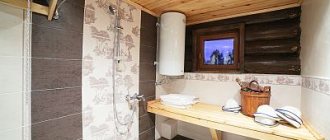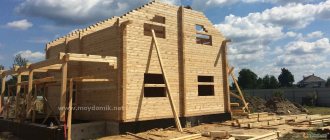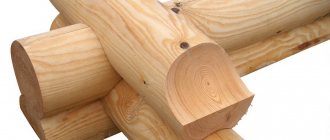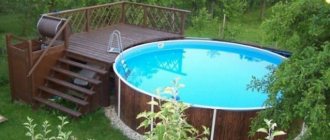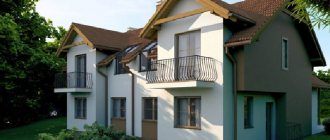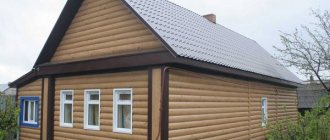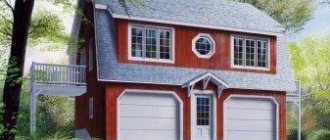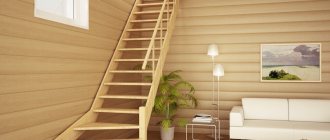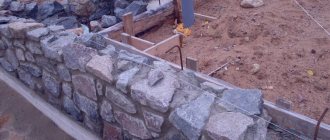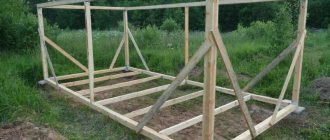In recent years, the trend of environmentally friendly housing has become increasingly fashionable, since most of the materials used to build “ordinary” houses contain harmful chemical compounds that negatively affect human health. And indeed: in nature there are plenty of natural materials that can be used for the construction of walls and roofs, as well as the interior and exterior decoration of houses.
In addition, nature also has in its “arsenal” sources of supplying humans with all the energy resources necessary for life. Many city residents who dream of a country house choose environmentally friendly buildings, but have no information on where to start. Therefore, this publication will present options for eco-houses, as well as information about the materials from which they are built.
Building an eco-house: suitable materials, communications and step-by-step instructions
Ecohouse - what is it?
An eco-house is not just a fashion trend: such buildings are the future. Therefore, in many European countries there are government programs aimed at developing projects for buildings built from environmentally friendly materials, in which alternative energy sources are actively used. For example, in Germany, back in 1996, the first such project was implemented. For Russia, this trend is new today, but many owners of suburban areas, having learned about it, are trying to apply its elements in their home.
An eco-house in the shape of a mansard roof, built in Romania
An eco-house is a maximally autonomous structure that allows you to save energy resources due to the heat capacity of the materials used for construction, as well as the installation of engineering life support systems for one or more dwellings.
Important! Water supply is provided from wells and wells; water is heated using renewable energy obtained from solar panels, geothermal heat pumps, etc. Eco-houses, completely disconnected from external sources of electricity or supplied with only 10% of them, are otherwise called passive.
Basic requirements for building an eco-house:
- energy efficient and simple building design;
- use of environmentally friendly materials;
- arrangement of an autonomous heating and air conditioning system;
- the use of alternative energy sources to ensure normal human life;
- autonomy of all engineering systems;
- development of an energy-efficient building layout, for example, a minimum number or complete absence of north-facing windows.
Construction of an eco-house: dream or reality
Interest in the construction of eco-houses is growing every day - projects that previously seemed fantastic are being brought to life and showing amazing results. Some principles of eco-friendly housing are familiar to anyone who has lived or vacationed in a village.
To this day, outside the city, houses are built from rounded logs, timber, bricks - that is, natural materials that do not contain harmful artificial impurities.
Scheme of a two-story residential building using the “double timber” technology – walls, internal floors, ceilings are made of two layers of wood (profiled dry pine timber)
Advanced villagers and summer residents have long installed septic tanks and biological stations - compact modern waste processing systems. Household plums decompose naturally, then the solid sediment is used as fertilizer, and the liquid is purified (up to 98%) and put into secondary use - for watering the garden or vegetable garden, and maintaining the territory.
Diagram of a biological water treatment system with two chambers (aerobic and anaerobic) and a filtration field. After purification, the liquid enters the ground
Of course, with the heating system everything is different: as before, the main source of heat is either an electric (gas, gasoline, coal) boiler or a stove, which is heated in the old fashioned way with wood. In environmentally friendly systems, the use of natural fuel (gas, coal, firewood, petroleum products) is excluded.
The use of solar panels leads to economical consumption of the generated electricity, because the power of the alternative system is not enough to ensure the operation of energy-intensive devices
The following are recognized as optimal sources of energy and heat:
- hydrodynamic heat generator with cavitator;
- solar powered system;
- wind home generators;
- biogas plants (for farms).
The functioning of smart heating systems, energy saving and waste recycling are combined, and the result is full autonomous maintenance of the house without any air or soil pollution.
An eco-house with an area of 48 m², designed by Romanian specialists, is built of laminated timber and double-glazed windows, the roof is covered with wooden tiles. Cost – 25 thousand euros
It turns out that if you wish, you can build an absolutely “clean” house yourself, especially since there are plenty of examples - in the countries of Scandinavia, Austria, Germany, Denmark, and Great Britain, hundreds of ecological housing projects are being developed, not only by nature lovers and representatives of “green” groups, but and government agencies.
Materials for building an eco-house
To build environmentally friendly houses, materials such as wood and straw, stone and glass, clay, soil and gypsum are used.
- Wood - this is the best material for an eco-house, as it has natural warmth, and many believe that it also has positive energy. Logs or beams can be used to build walls. A log house is built from them, which is insulated with flax tow or moss.
A log house has been tested for strength for centuries, so it would not be a mistake to choose wood.
In addition, a house that has a frame structure and combined with natural insulation will be warm in the winter and keep cool in the summer heat. - Mud walls or built from soil mixed with stones, clay and sand are also an excellent option. As a rule, houses built from these materials have a wall thickness of 600 millimeters or more, and are characterized by good heat and cool retention. In this case, the material will have an affordable price.
Adobe is also time-tested and, despite the fact that today innovative building materials are being developed and put on sale, builders are in no hurry to abandon blocks made of clay and straw - Adobe blocks They are also a good proven building material made from clay and straw. The house they make is warm and durable. The design also keeps you cool in summer and warm in winter.
Straw blocks are used as an independent material for the construction of walls or as an insulating material in a frame structure - Straw blocks have high thermal insulation capabilities, are easy to work with, and the material is affordable. When choosing straw blocks as the main material for the walls, they are fastened together with timber, which gives strength to the structure. This material is also used for laying in frame walls, which makes them warmer and more durable than when using mineral wool.
- Brick and stone are reliable and, of course, durable materials, but they have one significant drawback - high thermal conductivity. Therefore, walls built from them require good insulation.
Ceramic tiles, metal with a colorful coating or reeds are well suited for roofing in eco-houses.
Reed is a unique material that can keep your home warm in the harshest winters and cool on hot summer days.
The main environmentally friendly materials for the walls and roof of an eco-house are listed above. Of course, working with these materials is somewhat more difficult than with ready-made blocks, but all the work will not be in vain. After the façade of the walls is leveled and painted, no one will even think that the house was built from “off-hand” materials.
Green building in The Sims 4
When you hover over an object, you can see whether it has an impact on its eco-footprint. Depending on what materials the object is made of, it can be either environmentally friendly or industrial. To build an eco-house, you need to use as many materials as possible that have the status of “environmentally friendly” and completely abandon industrial ones.
Please note that many items from the base game and earlier expansions have these statuses, so you cannot simply filter by Sustainable Living to see all items made from natural materials. Unfortunately, there are no additional status filters in the game yet, so you will have to look at everything manually during the construction process
Let's hope that the developers will add such a filter in one of the future updates (though we shouldn't count on it, considering how many years it took them to add sorting to the character's luggage).
Roofs - two new types of roofing can store water and electricity. Living Roof (Water Factor 1) and Solar Tile Roof (Energy Factor 1)
- Wall coverings - most of them have received "industrial status", seriously limiting the possibilities for home design. However, if you use not only eco-friendly coatings, but also neutral ones, it is quite possible to create a unique, cozy interior.
- Floor coverings - the situation here is a little better than with wall coverings: there are more floors made from natural materials, but not so many industrial ones.
Plants - Use as many live plants, flowers and shrubs from Build Mode as possible.
Please note: flowers in pots and other indoor plants from the purchase section (Decor category) do not have a positive impact on the environment, unlike outdoor vegetation. Hedges - most are neutral, with the exception of new wood and green bush hedges
Hedges - most are neutral, with the exception of new wood and green bush hedges
Windows and doors - as with other objects, you need to pay attention to whether they are made of natural materials. There are many interesting designs that are not similar to those that were previously in the game
Windows can be beautifully decorated using building codes.
Friezes, stairs, roof sculptures, window sills, arches and other small things do not affect the eco-footprint in any way.
Please note: The use of certain items in construction may provide benefits, reducing the amount of bills. Data on the presence or absence of benefits can be seen when viewing information about the object
Industrial facilities, on the contrary, can increase the bill amount.
Tiny houses
The smaller the house, the easier it is to strike a delicate balance between energy/water consumption and production. Also, the small size of the house allows you to get rid of everything you need and leave only really necessary and useful things. In addition, you do not need to spend a lot of electricity on lighting. If you have the Sims 4 Tiny Living add-on installed, a tiny house will also provide a positive bonus for living in it.
Materials not used in eco-houses
When starting to develop an architectural project for an eco-house, you must immediately stop using materials containing toxic substances for construction and finishing. Such popular materials today include polystyrene foam, vinyl, and insulation materials containing formaldehyde.
European standards name four specific substances that should not be contained in materials used in the construction of an eco-house: VOCs, phthalates, formaldehydes and petroleum products. To understand in more detail what they are, you should consider some of their characteristics.
VOCs (volatile organic compounds)
VOCs are organic pollutants that, unfortunately, are found in most household products today. They are found in varnishes and paints, detergents and cleaning agents, office supplies and materials for making furniture. When indoors, these substances negatively affect the microclimate, which can lead to poor health, dizziness, nausea, and in the worst case, damage to internal organs.
Marking installed on products that have a safety certificate for household use
To avoid such consequences, when purchasing various products and materials, you should carefully study the labeling and choose products with “low VOC content” or “no VOC.” However, the Russian consumer is more familiar with the CE designation, which indicates the safety of the product.
Important! If they are already present in the house or there is a need to use them, then they should be used in non-residential or well-ventilated areas.
Phthalates
Phthalates are chemicals also found in many household products, from perfumes and bathroom curtains to adhesives and insecticides. In this regard, it is quite difficult to protect the family from contact with them. It should be borne in mind that according to WHO, phthalates can enter the human body through airborne droplets, water and food. It should be noted that according to research, many scientists are inclined to believe that phthalates should be classified as carcinogens.
Glassware is an environmentally friendly product that is safe for humans
To minimize human exposure to these substances, the first thing to start with is to stop storing food in plastic containers, preferring glass containers.
Formaldehyde
Formaldehydes are chemicals found in most building materials, including pressed wood products such as plywood, fiberboard and chipboard. Today, a large amount of furniture is made from these materials, and buyers, trusting manufacturers, use them without thinking about the consequences that their use may lead to. Formaldehydes, according to studies, emit fumes into the environment throughout the use of such materials, causing tearfulness, nausea and general ill health. In addition, laboratory experiments have revealed a connection between these substances and the occurrence of cancer in laboratory animals.
Wooden furniture is an integral part of an eco-house
To protect your home from these substances, ideally use furniture made from solid wood and do not use mineral wool containing formaldehyde resins to insulate your home. In addition, the house must have a high-quality ventilation system, with the help of which all harmful fumes will be removed from the premises.
Petroleum products
Petroleum products today are present in almost all products and products used in everyday life, for example, paraffin and the widely advertised Teflon, plastic, paints, nail polishes, etc.
Having studied the presented photo collage, we can conclude that it will not be possible to completely eliminate products containing petroleum products from use, but minimizing their use is quite possible
If you set a goal to minimize the use of these substances in your home, you should be careful about the products and materials you purchase. Having decided to purchase this or that item, just open the desired Internet page and inquire about the composition of the material from which it is made. After this, you can draw conclusions about the need to purchase it.
In addition, you need to pay attention to the presence of the above markings established by pan-European standards.
The use of cavitation in water supply
Cavitation turns out to be very useful if the eco-house is located far from civilization, and water from nearby sources needs to be disinfected. Let's first consider traditional methods of water purification, and make sure that hydrodynamic technology has undeniable advantages.
Traditional water disinfection technologies
Some of these techniques are used everywhere, others - occasionally, but they are known to everyone who studied physics and chemistry courses at school:
- chlorination;
- ultraviolet irradiation;
- ozonation;
- iodization;
- ultrasonic disinfection.
The most popular method of chlorination has as many benefits as harm. Not only does chlorine not destroy all bacteria, it is involved in the synthesis of new substances that are toxic and hazardous to health. Of course, the environmental friendliness of chlorinating water for home use is out of the question.
Ultraviolet radiation is useless for neutralizing water with turbidity and the presence of suspensions, so this method is only good for clear liquids. Ozone does an excellent job of cleaning water, but its production requires high voltage and a large amount of electricity, and the substance itself is toxic and explosive. Ultrasound technologies are not sufficiently developed; the main development has so far been found only in medicine - for the disinfection of instruments. There is also little use of iodine, which is only in demand for cleaning swimming pools.
Ecological hydrodynamic method
This technology is so effective that it allows water purification on an industrial scale, that is, one installation is enough for 2-3 houses (if the productivity is 500 l/hour). The only condition for complete disinfection is the absence of suspension. To carry it out, water is taken from the upper layers of the source (river or lake), and then the water is additionally filtered and settled in a special tank. After cleaning by cavitation, even domestic wastewater that has passed through a deeply purified septic tank becomes potable.
The operating principle of the cavitation unit is simple. The water passes through the filter, then the heat exchanger and enters the hydrodynamic system, where it is processed by cavitation. Then it returns to the heat exchanger for cooling, from there to the cooling condenser and reaches the final stage - additional filtration. You can use several filters with carbon or carbon-silver cartridges. With the help of cavitation, water purity reaches 100%, and energy consumption is reduced by 40-50%.
This illustration confirms the flawless operation of the water disinfection installation. One of the containers contains dirty sewage water, the other contains water that has already been purified using the cavitation method.
For uninterrupted operation of the water disinfection installation, a voltage of 380 V, a power consumption of 7.5 kW, and a power supply frequency of 50 Hz are required.
Shape and design of the building
As the developers of eco-house projects note, their shape and color scheme are of no small importance, and not because of the aesthetic, but because of the rational side of the issue:
- ability to retain heat;
- ability to withstand natural influences;
- creating spacious rooms in small buildings;
- the color scheme of the house's exterior also affects heat retention - the best option for eco-houses are shades close to white;
- The exterior decoration of the house must have thermal insulation capabilities, that is, keep it warm in the cold season and cool on hot summer days.
Air purification in the home
Home ecology is impossible without cleansing the airspace. Plants help purify the air and improve the energy of living spaces. In this situation, indoor plants are indispensable. By absorbing carbon dioxide, they enrich the air with oxygen.
Such plants include chlorophytum, sansevieria, ivy, pelargonium, dracaena, ficus, anthurium and others.
They are more efficient than many household appliances. One large plant is used per 10 square meters of area, and one small plant per five square meters.
There are plants that not only purify the air, but also disinfect it, since their leaves contain essential oils (geranium, myrtle, bay tree, lemon).
You can use an air purifier to clean the air. It cleans the air of dust and toxic substances, disinfects and ionizes it.
Lighting in an eco-house
Lighting is another factor that should be given attention, since its arrangement should be aimed at reducing energy costs. The incandescent lamps familiar to Russians are not suitable for eco-houses - the best option would be economical lamps with a fairly high efficiency. For example, LED lamps that do not emit a lot of heat when burning would be an ideal option. In addition, this type of lamp is easy to recycle without causing harm to the environment.
The premises must have large window openings and at the same time be reliably protected from wind and cold
When arranging lighting, it is mandatory to use natural light. Therefore, most windows in eco-houses are designed on the south side, as well as in the roof. By choosing this arrangement, the rooms will be filled not only with light, but also with natural warmth.
Important! On the lower floor of the building, on its southern side, the best option would be panoramic windows, that is, a glazed wall.
To maintain heat and coolness at different times of the year, two- and sometimes three-chamber double-glazed windows, equipped with krypton or argon filler, and also coated with energy-saving film, are installed in the window frames of such houses.
What can a “green” UD do?
In the process of generating electricity and all other types of energy, the environment suffers. Despite filters and treatment facilities, powerful enterprises emit huge amounts of pollution into the air, water and soil. Most of them are toxic and pose a danger to all living things. Oil and gas rigs, coal mines, where raw materials are extracted for energy production, violate the integrity of the earth's interior, which is also dangerous.
Unfortunately, humanity has not yet learned to live without the use of heat and electricity, but it is already beginning to save it. A smart home is a prime example of this. An intelligent energy management system helps to really save resources. How does this happen?
Energy supply in an eco-house
Today, even in an eco-house, a person cannot do without electricity, but it must be autonomous. To produce energy, you can use different methods - solar panels or collectors and wind turbines, which accumulate natural energy, thanks to which the home is supplied with electricity.
Solar collectors should be turned to the south - then they will accumulate energy almost all day long
How to make a solar collector is described in detail in the article on our website “How to make a solar collector with your own hands.”
Windmills, or wind generators, can provide a home with electricity up to 75-80%. In combination with solar panels or collectors, housing will be fully provided with electricity.
Heating a house will require thermal energy - it can be obtained by installing geothermal heating or heat pumps, which are designed to extract heat from ground layers or water, if there is a body of water near the house.
Properly installed geothermal heating can provide heat to a certain area of the house
When installing film heating, which does not require a large amount of electricity, the same solar collectors or wind turbines can be used.
Principles of designing eco-friendly houses
If you still take a chance and decide to build an eco-friendly house with your own hands, you need to start with a project - detailed planning of all stages of building construction and connecting life support systems.
The first stage is choosing a construction site. The most favorable site is a flat area with a water source close to it, open to sunlight and wind. If northern winds often blow in the region, if possible, the northern part of the house should be protected (for example, by planting tall coniferous trees).
An interesting design solution is the partial construction of a house “in the ground.” Part of the building is protected and insulated in a natural way; the only drawback is the mandatory artificial lighting of the underground part
The second stage is to determine the nuances of building an eco-house. Thermal insulation of a house plays an important role - the more efficient the natural protection system is, the less energy will be spent on heating.
To increase the thermal insulation properties, several techniques are used, for example:
- strengthening thermal protection in areas with “cold bridges”;
- construction of a multi-layer wall structure (up to 4 layers with gaps filled with mineral insulation, waste from the cellulose or cotton industry);
- additional insulation of the foundation and basement.
An interesting architectural solution for the northern regions is the division of space into “winter” and “summer”. As you know, our ancestors also had a winter hut (with a Russian stove) and a summer one, which was not heated.
A lot of energy goes into keeping light bulbs running, so you should maximize natural light. To do this, one wall of the main room can be made of glass, using triple glazed windows with wooden frames and impact-resistant glass.
Option of a house with circular glazing. During daylight hours, almost all rooms of the building are illuminated naturally - through glass walls erected along the perimeter
The airtightness of the house will be extreme, so it is worth thinking about ventilation. The more useful qualities are incorporated during construction, the less energy will be required to provide the residential area with heat, light, and clean water.
The installation of “green” roofs creates an additional effect of insulating the building and retains rainwater. In order for grass to grow on the roof, technology has been developed for equipping inverted roofs.
Water supply and sewerage
Water and its disposal are vital factors, so you should consider where water will come from into the house and where it will be discharged. The same schemes are used here as in an ordinary private house, which is not equipped with central sewerage and water supply systems.
A well is drilled on the site to extract drinking water, which is supplied to the house using a pump.
Septic tanks can have different designs and are made of different materials
Important! A septic tank is installed to dispose of wastewater.
An excellent help for any private home would be a rainwater collection system, its purification and use for the washing machine, dishwasher, watering, car washing and even for the shower.
Rainwater harvesting system
Such a system will help save a fairly large amount of drinking water, and most importantly, the family will always have a supply of water in case the well dries out or for the period of its cleaning.
Secrets of the comfort of an eco-home
Eco-style living does not like perfectly smooth surfaces and sharp corners. The smooth lines of the walls flow into the built-in furniture: stoves, beds, niches and pantries instead of cabinets. The color scheme of the interiors should be kept in natural tones. Instead of wallpaper, the walls are whitewashed, covered with wood, and decorated with fabric or ethnic textiles.
The interior of this eco-house is not out of style in any detail.
Another feature of the eco-style of life is the abundance of coarsely sculpted ceramics, wicker items, and carved wood. There is also a place for women’s hobbies: embroidery, knitting, macrame. Therefore, eco-housing develops the creative abilities of those who live in it. And it calms the psyche - both in the process of working on a new thing, and from its subsequent use.
In this eco-friendly home, each ceramic tile is unique and handmade.
Construction of eco-housing requires a lot of manual labor. This includes clay kneading and artisanal wood processing. When hiring craftsmen, be sure to take part in some process to leave your energy in the house. Then it will become a real “family nest” and will give you comfort, warmth and reliable protection.
One of the houses is legendary in Carmel, a town in California. There are a lot of amazing green buildings there
Heating does not have to be limited to a stove or fireplace. Warm floors or radiators can be used in a modern eco-house, but the boiler and radiators are “hidden” behind decorative elements. And you can’t do without a bathroom and water in the kitchen. It is necessary to take care of good ventilation and waterproofing of the walls in these rooms so that natural materials do not attract dampness, otherwise mold will appear.
The eco-house has everything you need for a comfortable life
Ventilation system
In any home, the most important issue is the arrangement of the ventilation system, since the health of the microclimate depends on it.
The recuperator regulates ventilation in the eco-house
A recuperator is a device that circulates air and at the same time retains heat inside a building. That is, it works on the principle of recovering heat flows from ventilation. Therefore, there is no heat loss through the ventilation ducts, as if exhaust fans were installed in them. Supply fans bring cold air into the premises, which requires energy to heat it. Thanks to its capabilities, the recuperator is becoming increasingly popular among owners of private houses.
Video example of arranging such a house
- Author: Yana
Rate this article:
- 5
- 4
- 3
- 2
- 1
(4 votes, average: 3 out of 5)
Share with your friends!
Local sewage system of a country house: a comparative review of treatment facilities
Air heating of a private country house: principles of design, selection of equipment and calculation
"Smart Home" system
To ensure that all extracted resources are used rationally, as a rule, a “smart home” control system is installed in an eco-house.
The larger the area of solar panels, the more renewable energy will enter the house
The system controls the optimal temperature and humidity in the premises, ventilation operation, air flow and other parameters. When there are no people in the premises, the Smart Home switches the operation of all climate control devices to saving mode, which allows for proper use of energy.
In addition to climate control devices, the system can regulate the supply of hot water and the temperature of heating devices.
Important! In the absence of a smart system, it will be difficult to keep track of all the parameters and save the extracted energy.
Today, in Russia, there are companies developing eco-house projects that include all communication systems. If you plan to start building your own home in the near future and want to get rid of materials that negatively affect human health, you should think about an environmentally friendly building. However, it should be understood that the construction and furnishing of such a house will not be cheap.
What “bricks” are used to build an eco-friendly house?
Someone said - we did not inherit our land from our parents, we rented it from our children. When you look at your lifestyle from this angle, of course, you begin to understand that the next generations will pay for our every step
At this stage, it is important to learn at least not to harm the earth on which we walk, and only then, having realized these principles, learn to cooperate with it
Once you recognize the need for change, it is important to take the first step. After all, as the Chinese proverb says, the road of a thousand miles begins with him
How to make your own home eco-friendly?
Learn to be friends with trash
The average person produces 30 kg of waste per day. Imagine a small child about 10 years old, his weight will be the same.
Use less plastic containers, bags, boxes, because they account for the lion's share of all waste. Why would you put bananas in a bag if they will keep just fine without it? Why do you need to buy disposable bags in supermarkets every time, if special reusable fabric bags have long been available that you can always carry with you? They take up very little space. Or use biodegradable bags, which then make great trash bags.
This will help you see how much waste you produce and help you send it for recycling. All waste is usually divided into glass, iron, cardboard, plastic and technical waste.
For example, there are special trash cans for batteries. Do you know that you can get a lot of useful substances from them and even make fertilizers for the soil?
In Russia, the idea of waste sorting has just begun to emerge, but almost every city already has special waste separate collection points.
Make your life more environmentally friendly - organize such a trash bin yourself in the yard of your home! You will see others follow you.
Use water and electricity correctly
You can make your home eco-friendly by using resources wisely.
When washing dishes, first lather them without turning on the water, and only then carefully rinse off the foam. Water your flowers using recycled water, such as the same water you used to wash your fruits and vegetables. Don't forget about the washing machine; many of them already have an environmentally friendly washing function built in.
By the way, such water savings
will have a positive effect on the state of your wallet.
By the way, you can make many cleaning products yourself. It will cost you pennies, which again will save your wallet, and is also very much in the spirit of being an eco-friendly householder. The women's club "Those Over 30" has already told its readers how they can switch to eco-friendly, homemade laundry and dishwashing products.
How many times do we leave the room leaving the light on, forget to unplug the computer, forget to unplug the charger after turning off the phone? How many times do we turn on the TV in the background, not caring at all about how much it “eats”? An eco-friendly modern home can and should be energy efficient.
Replace regular batteries with energy-saving ones,
Always turn off the lights before going out and order solar powered chargers.
And what’s most interesting is that all this will again save you a lot of money.
Consume less
Did you know that it takes 2,500 liters of water to produce one T-shirt? Now count how many clothes are hanging in your closet.
According to statistics, 25% of humanity overeats, and 30% of humanity (mostly in poor countries) is hungry. Try to watch what you eat and what you buy,
make a shopping list, taking into account the same ingredients for preparing different dishes.
Choose eco-friendly furniture
Now, fortunately, finding it is also not a problem. Such furniture is usually cheaper, but looks much more interesting,
than any standard options. These are, for example, furniture made of rattan and bamboo.
An expensive option, but always remaining in trend, is solid wood furniture.
So, in just a few simple steps, you will learn not only to live a conscious, environmentally friendly life,
but you can also save a lot of money. And remember that every good habit takes only 21 days to be implemented in a person’s life.
Why not start today on your path to a happy life in an eco-friendly home with a harmonious atmosphere?
For those over 30 – a club for women over 30.
Master class: building an inexpensive, energy-efficient eco-house
You can build such a house yourself, and you don’t necessarily have to spend a lot of money on it. The step-by-step instructions below will help you build an energy-efficient eco-friendly straw house.
| Sequencing | Description |
| The foundation for the future eco-house is poured monolithically. This is quite a difficult job, and it cannot be done alone - it is advisable that at least 4 people participate in this process. It may be better to entrust this matter to professionals. First, differences in ground height are examined, then the construction site is carefully leveled, waterproofing is laid, and a reinforcement frame is created. Then the concrete solution is poured and left for 4 weeks. |
| Along the perimeter of the foundation of the future eco-house - in those places where the walls will be erected - roofing material is laid for waterproofing. |
| The next step is laying the wall trim. Its width is 40 cm, respectively, and the thickness of the walls will be the same. It is important to note that the lower trim can be insulated - for example, with ecowool or linen insulation. |
| The walls in the eco-house are sandwich panels tightly stuffed with straw. They are installed and fastened together using powerful screws and screwdrivers. They are also fixed to the lower harness. |
| Reliable lintels are installed in window and door openings - these are also panels stuffed with straw. |
| Sandwich panels are installed: the result is a frame-straw structure - the reliable walls of a future energy-efficient eco-house. |
| The next step is to fasten the walls from above with the top trim. A Mauerlat is installed on it. |
| Next comes the installation of the rafter system. The rafters are also connected to each other using bolts and screws, using fastening metal corners and plates. |
| A continuous sheathing made of plywood produced using bio-glue is laid on top of the rafters - this material is ideal for an eco-house. A counter-lattice is placed on top of it, onto which the roofing straw is fixed. |
| When the roof is completely ready, you can proceed to installing windows and doors. It is also important to choose them correctly - those made of fiberglass or wood are good. |
| The only thing left to do is the façade cladding. It is produced using panels made using wood shavings and clay. Then the facade can be plastered with clay mortar and painted with environmentally friendly paint. |
We are building an eco-house - a hobbit house and an earthen ship
It would seem that these houses are part of the land itself; the presence of the house in the hill is revealed only by the facade and a few windows. Homes built partially underground have a number of incredible benefits, such as the ability to absorb and regulate solar heat, keeping the home warm during cold weather.
Houses of this type can be built entirely underground, covered with an embankment of earth on one or three sides, or built into a hill, when only the front part of the building remains open.
The construction of an eco-house, the so-called “earth ship,” requires the use of waste bottles, cans, and car tires, which are filled with earth and houses of the most incredible shapes and sizes are built from these “garbage” materials. Beginners, of course, build houses of the simplest design, which require less effort and expense. However, there are many “earthships” in the world that are masterpieces of the art of construction.
Ecological materials for home insulation
- Ecowool
Ecowool is the most popular environmental material for home insulation. It does not emit hazardous substances, while effectively retaining heat inside the building. Due to the tight fit of ecowool to the base, there are no voids left, so cold bridges do not form. This is the advantage of this insulation compared to slab heat-insulating materials.
Ecowool does not ignite; manufacturers specifically conducted testing, during which this property was revealed. Moreover, this material will prevent the fire from spreading if a fire occurs. Ecowool is produced using boron antiseptic, so fungus does not form on it, insects and mice do not grow on it.
- Foam glass
This insulation has also gained popularity among home owners who use it to insulate cottages. Foam glass has excellent parameters, which are confirmed by a quality certificate. This material has the following characteristics:
- resistant to fire;
- not afraid of moisture;
- lasting;
- non-flammable;
- has a long service life;
- Resistant to chemical attack.
Foam glass has one drawback: this insulation cannot be called budget.
- Insulation "Wave"
A natural heat insulator made from flax production waste. Made in the form of mats in which the finest linen fibers are combined using polymers.
“Wave” is non-flammable, this insulation is used for both external and internal work. It also has excellent sound insulation characteristics.
This insulation is treated with a special antiseptic, so rot and mold do not form in it.
There are mats on sale with an aluminum film attached to one side, which reflects thermal energy. If you mount the “Volna” with film to a building, you will achieve the effect of a thermos. Therefore, the house will be better kept warm.
- Wood shavings
The insulation, made in the form of slabs of compressed wood chips, is an environmentally friendly material. High-temperature production technology ensures the integrity of the slab: the wood releases resins, as a result of which the chips stick together tightly.
TOP 5 articles on construction:
- Is it possible to build a second house on the site: we understand the legislation
- Location of the house on the site: taking into account cardinal directions, distance to neighbors and regulations
- What is the best material to build a house from: a review of popular materials
- House for 2 families with different entrances: layout and advantages
- Maternity capital for building a house: how to get and spend
- Stone wool
This thermal insulation material is also quite popular. This natural insulation is non-hygroscopic, so it retains its properties even if the house is located in a humid climate. To install stone wool, you will need to make a vapor barrier.
This insulation does not ignite, does not release hazardous substances into the air, and does not allow extraneous noise to enter the room. The price of stone wool is high, but the costs will quickly pay off, especially if you are building a frame cottage.
House with panoramic windows: light and warmth Go
- Styrofoam
Polystyrene foam is also an environmentally friendly insulation material; it is budget-friendly and can be purchased at any hardware store.
However, if a fire occurs, the foam will begin to release toxic gas. As a result, there is a risk of poisoning. This insulation cannot be used in all cases.
Should we blindly trust foam concrete?
Foam concrete in Europe is also called eco-concrete. In the list of environmental materials it comes right after wood. Environmentalists love him.
There is an article on FORUMHOUSE in which the composition of foam blocks is literally broken down into molecules. It seems to be completely safe.
Foam for foam concrete is made from natural ingredients, aluminum is included in the blocks in the form of safe compounds, the likelihood that “contaminated” cement and sand, sources of radioactive radiation, will get into its composition is close to zero. The composition of cellular concrete includes lime and safe quartz sand, and not granite crushed stone - you don’t have to worry.
But you still can’t relax completely when buying foam blocks. Foam concrete may contain ash and slag contaminated with heavy metals and containing a high concentration of radioactive elements.
It all depends on the integrity of the block manufacturer.
MISHA_KFORUMHOUSE Member
Marble is also phonic, but the marble is mostly imported; at all borders there are dosimeters for trucks - it’s easier here. And local production - whatever you want, as long as it’s cheaper.
As we see, this super eco-friendly material can also be unsafe. You still need to read real reviews, recommendations, and look for reputable sellers and manufacturers.
List of documents that need to be studied before purchasing foam blocks:
- environmental certificates;
- GOST certificates of conformity;
- sanitary and hygienic conclusions;
- documents confirming the absence of radionuclide emissions.
Environmental rating
The international expert community has developed a so-called rating of safe building materials that are used to construct the walls of residential buildings. In the first place is the most environmentally friendly option, in their opinion, and then the positions go in descending order.
Straw. Dry wheat stalks take first place in the ranking. “Thatch” houses began to appear long before the use of stone and clay. Moreover, there is a theory that the first wheat crops appeared precisely for the purpose of procuring building material, and not for the sake of obtaining grain.
Raw clay. In the Middle Ages, houses made of adobe made up the majority of the housing stock of European cities. Such buildings are still popular, and in recent years there has even been an increase in demand for them in developed countries. Scientists in different countries conducted independent studies of clay houses. According to the data obtained, even a short stay in such a home has a beneficial effect on a person’s well-being.
Wood. The honorable third place goes to natural wood. The environmental friendliness of this material does not require additional explanations or evidence. But, along with high consumer properties, there is also a constant increase in prices for construction wood, which forces manufacturers to develop new, composite materials such as wood concrete. The presence of additives and binders reduces costs, but also reduces the degree of environmental friendliness.
Gypsum. Gypsum comes fourth in terms of environmental friendliness. The mineral is mined in quarries developed in many countries around the world. Blocks, bricks, sheet materials, building mixtures and much more are made from it. It is impossible to use mineral deposits in their pure form due to their fragility, so manufacturers process raw materials at high temperatures using special modifiers. In addition to environmental friendliness, it is worth noting the fire-fighting properties of gypsum.
Ceramic and silicate bricks. Ceramic bricks are made from clay mortar using high-temperature firing. The production technology requires large energy costs, and after fuel combustion, slag, soot, and volatile compounds of sulfur, carbon, and nitrogen are formed, so ceramics are ranked only in fifth place in terms of environmental friendliness.
Sand-lime bricks are produced by pressing a mixture of quartz sand, slaked lime and water at elevated temperatures. Energy costs are lower than in the production of ceramic materials, and environmental performance indicators are at the same level. The disadvantages of sand-lime brick include the ability to absorb moisture and crumble in a fire.
Brick
Humanity has been building with bricks for a long time. The clay used to produce bricks is fired, and the brick itself may contain various additives. The main possible harm from a brick may be that the clay used in its manufacture may be radioactive.
On Earth, any material, any substance is radioactive. Natural background radiation is observed everywhere. And that's okay.
But there is absolutely no need for increased background radiation in your own home. Therefore, we check the purchased batch of bricks with a regular dosimeter. There is no excess of natural background radiation, you can safely build your home from such bricks.
Absolutely and conditionally environmentally friendly materials
Absolutely environmentally friendly materials are considered natural, those from which our ancestors built their houses for centuries: wood, stone (in extreme cases, brick), straw, natural drying oil, slate, clay, and so on.
Conditionally environmentally friendly building materials include more modern, but also seemingly safe:
- brick;
- roofing tiles;
- foam concrete blocks;
- materials made from aluminum and silicon.
Natural drying oil - who has seen it?
Adherents of ecological housing try to treat wooden log houses with natural compounds, for example, natural drying oil. The photograph shows the result of such processing.
The man specially ordered linseed oil and wax from Altai, heated it, mixed it and processed it.
This method also has several pitfalls: it is incredibly expensive; not everyone can withstand such a colorful ornament; It is very difficult to get real natural drying oil and real linseed oil. And most importantly, this coating is not intended for outdoor use.
TulupFORUMHOUSE Member
Over the course of a year, the coating with drying oil practically disappears, as if it evaporates and the wood remains almost dry. To give it a presentable appearance, it needs to be coated again. I believe that it has the right to life as an inexpensive treatment of unpresentable structures.
Drying oil is a vegetable oil, hemp, linseed or nut, partially polymerized by heating or other means. FORUMHOUSE describes cases where workers offered to cheaply and environmentally treat a log house with hot sunflower oil. But you cannot replace linseed oil with sunflower oil: it does not dry out completely, never forms a film, but it darkens and turns bitter.
MumiForumHouse Member
No workers will get flaxseed; it is not widely sold. They will heat you up oxol with the addition of technical rapeseed oil and hello.
Another point: our participant with the nickname SDP claims that natural drying oil is very difficult to get. Even artists have a big problem with this: it’s just that now Shrovetide flax varieties are grown in rather modest quantities in the vast expanses of the former USSR.
SDPU member FORUMHOUSE
For artists, getting natural, even sunflower-based, drying oil is a big problem. Varnishes are made from linseed and hemp oils, which I use to treat luxury leather and luxury furniture, the price is astronomical!
Therefore, when finishing wood with something natural and environmentally friendly, it is good to make sure that it is not a fake.
What are the dangers of wood
Wood is one of the most environmentally friendly materials, the main material for the construction of eco-houses. The tree is good no matter how you look at it. Many people note: in log wooden houses it is always easy to breathe, they have an optimal microclimate and there is no dampness. It is from wood that frames for thatched houses are made.
But here it is important that the wood is harvested in winter and well dried. And it’s always worth thinking about what protective compounds it has been treated with. Wooden structures are treated to protect them from mold, fungi, ultraviolet radiation, humidity, bark beetles, and so on. Usually two compounds are applied: against insects and against environmental influences.
A number of these protective agents are truly dangerous for humans. Many chemicals are considered harmless, but it is no longer inappropriate to talk about the absolute environmental friendliness of wood after their use. In addition, any paint and varnish product can become dangerous if it is not stored correctly.
Of course, you can refuse synthetic protective compounds: thank God, in Rus' houses were cut down long before they appeared. But here the question fully arises of how ready people are for this.
FortunaForumHouse Member
We must not forget the secrets of the old masters. But I wonder what percentage of homeowners would agree to coat the inside of their new, newly built house with clay? How many people will refuse to impregnate wood with Finnish protective compounds and prefer a saline solution?
